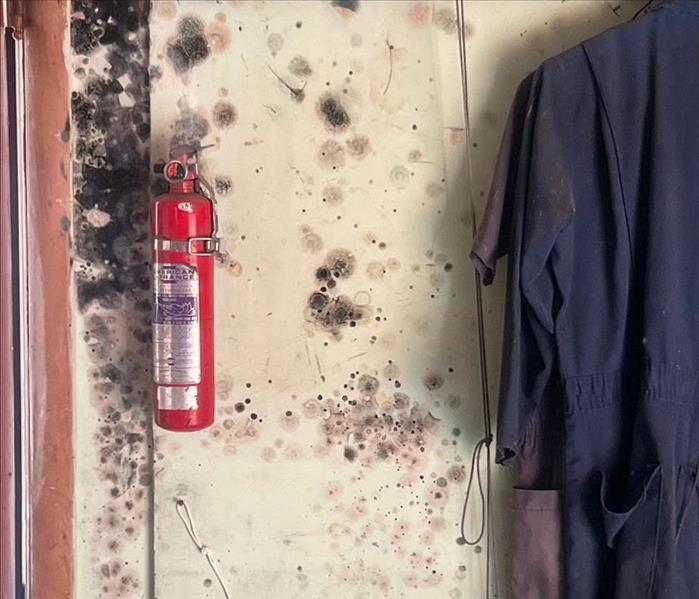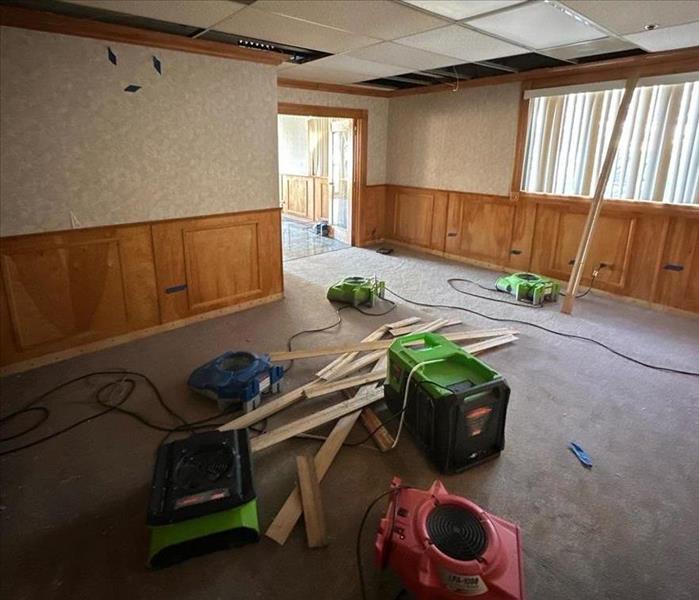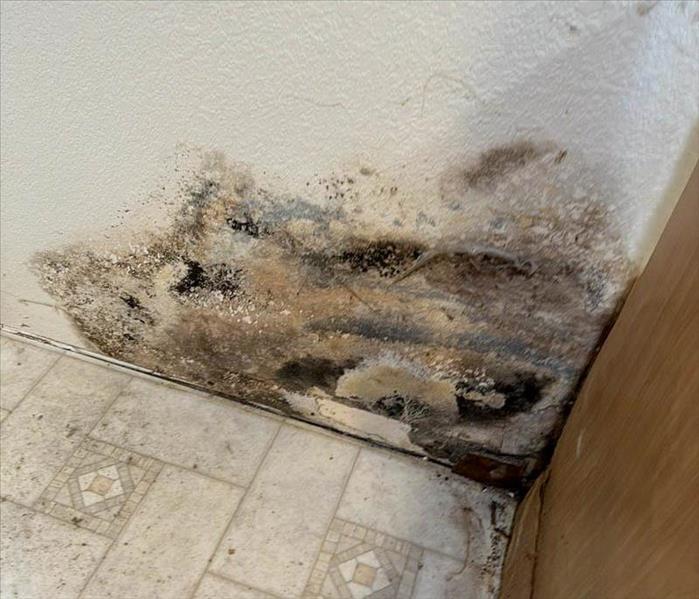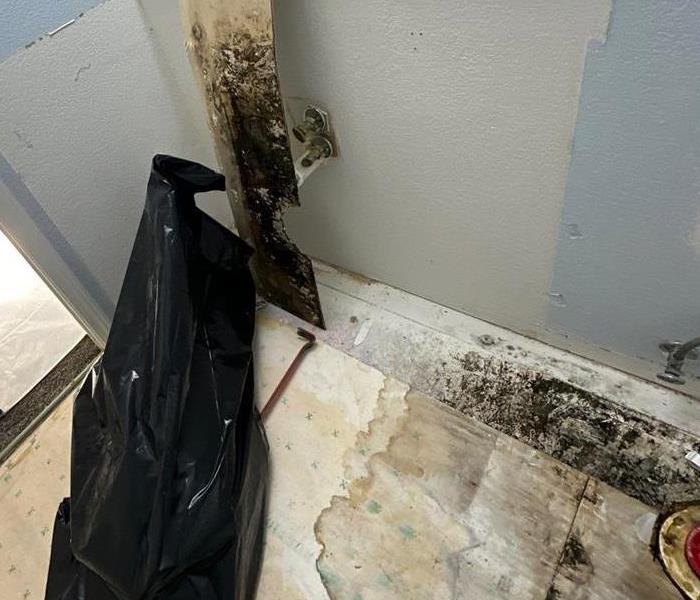Archived Mold Remediation Blog Posts
Mold Removal vs. Mold Remediation: Understanding the Difference for Effective Solutions
10/1/2024 (Permalink)
Mold growth in your home or business can be an alarming discovery. Whether it’s caused by moisture buildup, water damage, or inadequate ventilation, mold can spread rapidly if not addressed properly. When it comes to dealing with mold, two common terms are often used interchangeably: mold removal and mold remediation. While they may sound similar, there are key differences between the two processes.
In this blog, we’ll break down the differences between mold removal and mold remediation and explain why professional services, like those provided by SERVPRO®, are essential for addressing mold issues effectively.
What Is Mold Removal?
Mold removal refers to the process of physically removing mold from a surface. This may involve cleaning, scrubbing, or scraping mold off walls, floors, or other affected areas. While this process can reduce visible mold, it’s important to note that mold spores are microscopic and often remain in the air or on surfaces even after visible mold is gone.
The Limitations of Mold Removal
- Surface-Level Cleaning: Mold removal only addresses the surface where the mold is visible. It doesn’t tackle the root cause of mold growth, such as moisture problems or poor ventilation.
- Incomplete Results: Because mold spores are microscopic and airborne, simply cleaning the surface doesn’t remove the mold spores from the environment. These spores can land on other surfaces and cause mold to grow again if conditions are favorable.
- Temporary Fix: Without addressing the underlying issue, mold can easily return, making mold removal a temporary solution at best.
What Is Mold Remediation?
Mold remediation, on the other hand, is a comprehensive process that involves not only removing the mold but also addressing the underlying factors that contribute to mold growth. The goal of mold remediation is to restore mold levels to a natural, safe level and prevent future mold growth by eliminating the source of the problem.
The Mold Remediation Process
- Inspection and Assessment: The first step in mold remediation is identifying the extent of the mold growth and determining its cause. Professional mold remediation services like SERVPRO conduct thorough inspections to find hidden mold and areas of moisture.
- Containment: To prevent mold spores from spreading to unaffected areas of the property, containment measures are used. SERVPRO uses specialized containment techniques such as negative air chambers and physical barriers to isolate the affected areas.
- Air Filtration: High-efficiency air scrubbers and HEPA vacuums are used to capture mold spores from the air and remove them from the environment. This reduces the risk of mold spores spreading to other areas of the building.
- Mold Removal: Once containment is established, the actual removal process begins. Depending on the severity of the infestation, mold remediation specialists may use antimicrobial treatments, remove contaminated materials like drywall or insulation, and deep clean surfaces.
- Addressing Moisture Issues: One of the most critical aspects of mold remediation is addressing the moisture issue that caused the mold in the first place. This might involve repairing leaks, improving ventilation, or installing dehumidifiers to prevent excess moisture from creating a favorable environment for mold.
- Cleaning and Restoration: After the mold is removed, cleaning and sanitizing the affected areas is crucial to prevent future growth. SERVPRO uses specialized cleaning techniques and equipment to ensure the area is properly restored. If structural materials were damaged by mold, restoration services may also be needed.
Key Differences Between Mold Removal and Mold Remediation
The main difference between mold removal and mold remediation is the depth and effectiveness of the process. Mold removal is a surface-level cleaning technique that addresses only the visible mold, while mold remediation is a comprehensive solution that tackles both the visible mold and the underlying causes of the problem.
Mold removal focuses on eliminating mold from the surface, whereas mold remediation involves a more in-depth approach, including containment, air filtration, and moisture control. Mold remediation is designed to prevent mold from coming back by addressing the root cause, while mold removal may only offer temporary relief.
Why Professional Mold Remediation Is Important
While mold removal may seem like a quick fix, it doesn’t provide a long-term solution. Attempting to remove mold yourself without understanding its root causes can lead to further complications, especially if mold spores spread to other areas of the home or business.
SERVPRO of Commerce City has professional mold remediation services that go beyond just removing visible mold. We take a comprehensive approach, ensuring that mold is contained, cleaned, and prevented from returning. Our team of certified technicians is trained to handle all types of mold problems, from small mold patches to widespread infestations in commercial properties. We use state-of-the-art equipment and proven techniques to safely and effectively restore your property.
If you’re dealing with mold in your home or business, contact SERVPRO of Commerce City for expert mold remediation. We’ll assess the situation, contain the mold, remove it safely, and address any moisture issues to prevent future growth. Let us help restore your property and peace of mind.
The SERVPRO Mold Remediation Process
7/17/2024 (Permalink)
 By following these steps, our SERVPRO team ensures that your home is thoroughly and safely remediated of mold.
By following these steps, our SERVPRO team ensures that your home is thoroughly and safely remediated of mold.
Dealing with mold in your home can be a daunting task, but with the help of professionals, the remediation process can be more manageable and effective. At SERVPRO®, we follow a step-by-step mold remediation process to ensure that your home is restored to a safe and healthy environment. Here's a breakdown of our mold remediation process:
1. Initial Assessment
The first step in our mold remediation process is to conduct a thorough assessment of the affected areas. Our certified technicians will inspect your home to identify the extent of the mold growth and determine the underlying cause of the mold. This assessment helps us develop a customized remediation plan tailored to your specific needs.
2. Containment
Once the assessment is complete, we take immediate action to contain the mold to prevent it from spreading to unaffected areas of your home. We use advanced containment techniques, such as sealing off contaminated areas with plastic sheeting and creating negative air pressure to prevent mold spores from escaping into the air.
3. Mold Removal
Next, we begin the process of removing mold from your home. Our technicians use specialized equipment and techniques to safely and effectively remove mold from surfaces and materials. We carefully dispose of mold-infested materials following industry standards and guidelines to prevent further contamination.
4. Cleaning and Sanitization
After the mold has been removed, we thoroughly clean and sanitize the affected areas to eliminate any remaining mold spores and prevent regrowth. We use professional-grade cleaning agents and disinfectants to ensure that your home is free of mold and bacteria.
5. Drying and Dehumidification
Mold thrives in damp, humid environments, so it's essential to address any moisture issues in your home to prevent future mold growth. Our technicians use high-powered drying equipment and dehumidifiers to remove excess moisture from the air and ensure that your home is properly dried out.
6. Restoration
The final step in the mold remediation process is restoration. Our goal is to restore your home to its pre-mold condition, which may include repairing or replacing damaged materials, such as drywall, flooring, or insulation. Our team works quickly and efficiently to minimize disruption to your daily life and get your home back to normal as soon as possible.
By following these steps, our SERVPRO team ensures that your home is thoroughly and safely remediated of mold, restoring it to a healthy living environment for you and your family. If you suspect mold growth in your home, don't hesitate to contact SERVPRO of Commerce City for professional mold remediation services. Our team is here to help you every step of the way, from assessment to restoration, to ensure that your home is mold-free and safe to inhabit.
DIY Mold Removal: When to Call the Professionals
3/13/2024 (Permalink)
 It's important to understand when it's appropriate to handle the job yourself and when it's time to call in the professionals.
It's important to understand when it's appropriate to handle the job yourself and when it's time to call in the professionals.
Discovering mold damage in your home can be alarming, but before you dive into a DIY mold removal project, it's important to understand when it's appropriate to handle the job yourself and when it's time to call in the professionals. In this article, we will explore the signs of mold damage, outline the steps involved in DIY mold removal, and discuss situations where professional assistance is necessary.
Signs of Mold Damage
Identifying the signs of mold damage is crucial in determining whether you should address the issue yourself or seek professional help. Look out for the following indicators:
- Visible Mold Growth: If you spot mold growth on surfaces such as walls, ceilings, or floors, it may suggest a more extensive problem. Large areas of mold growth often require professional attention.
- Musty Odor: A musty smell in specific areas of your home can indicate hidden mold growth. Investigate further to determine the source and extent of the issue.
- Water Damage: Any previous water damage, such as flooding, leaks, or high humidity, can promote mold growth. If there are signs of water damage, it's recommended to consult professionals for a comprehensive assessment.
Steps in DIY Mold Removal
If you decide to tackle minor mold damage yourself, it's important to follow the necessary steps to ensure your safety and effectiveness. Here's a general guide for DIY mold removal:
- Personal Protective Equipment (PPE): Before starting any mold removal process, don the appropriate PPE, including gloves, goggles, and a respirator to protect yourself from mold spores.
- Contain the Area: Use plastic sheeting and tape to create a barrier around the affected area. This will prevent the spread of mold spores to other parts of your home.
- Remove Mold-Impacted Materials: Carefully remove and dispose of any materials (such as drywall or carpet) that are heavily infested with mold. Double-bag and seal the materials to prevent contamination.
- Clean Surfaces: Use a mold-specific cleaner or a mixture of water and detergent to scrub the mold off hard surfaces. Thoroughly dry the area afterward to discourage further mold growth.
- Ensure Proper Ventilation: Open windows and use fans to improve airflow during and after the cleaning process. This will help dry out the area and minimize the risk of mold regrowth.
When to Call the Professionals
While DIY mold removal can be suitable for small-scale, easily accessible areas of mold, certain situations call for professional assistance. It's recommended to contact mold remediation professionals when:
- Extensive Mold Growth: If the mold covers an area greater than 10 square feet, it's best to have certified professionals handle the removal process. They have the expertise and equipment to safely address larger-scale mold problems.
- Hidden or Hard-to-Reach Mold: Mold growth in hidden spaces like behind walls or under flooring requires specialized techniques for proper detection and removal. Professionals have the necessary tools and knowledge to access these areas.
- Recurring Mold: If you have previously attempted DIY mold removal but the mold keeps coming back, it indicates a deeper issue that professionals can thoroughly assess and address.
DIY vs. Professional Mold Remediation
Knowing when to handle mold damage yourself and when to call in professionals is crucial for effective and safe remediation. While minor mold issues can be handled with DIY methods, extensive growth, hidden mold, or recurring problems necessitate the expertise of certified professionals. SERVPRO® technicians are trained in mold removal and remediation, available to address any size mold problem in your home. Contact us today to schedule a consultation and ensure a thorough and successful mold removal or remediation process.
What's the Difference Between Mold Removal vs. Mold Remediation?
11/8/2023 (Permalink)
 In Commerce City, CO, where humidity levels can vary, opting for mold remediation is often the best choice.
In Commerce City, CO, where humidity levels can vary, opting for mold remediation is often the best choice.
Mold issues can lead to a variety of problems in your Commerce City home or business. In this blog, we will clarify the differences between mold removal and mold remediation, helping you make informed decisions to protect your home.
Understanding the Basics
Mold is a common issue that can affect homes in Commerce City, CO, due to our climate and environmental factors. When facing a mold problem, it's crucial to understand the distinctions between mold removal and mold remediation.
Mold Removal
Mold removal often refers to the physical process of eliminating visible mold from surfaces. While it might seem like a straightforward solution, it's essential to note that it may not address the underlying issue causing mold growth.
Pros of Mold Removal
- Immediate removal of visible mold.
- May improve the appearance of affected areas.
Cons of Mold Removal
- Does not address the root cause of mold.
- Mold can return if the moisture source isn't addressed.
Mold Remediation
Mold remediation takes a more comprehensive approach. It not only involves removing visible mold but also addressing the underlying causes of mold growth, such as moisture issues and humidity control. This holistic approach helps prevent future mold problems.
Pros of Mold Remediation
- A comprehensive solution that addresses the root causes.
- Minimizes the risk of mold returning.
Cons of Mold Remediation
- May take longer to complete compared to simple removal.
Choosing the Right Approach
In Commerce City, CO, where humidity levels can vary, opting for mold remediation is often the best choice. It ensures that not only is the visible mold removed, but steps are also taken to prevent its return. Mold remediation professionals, like SERVPRO® of Commerce City, are equipped with the expertise and tools needed to carry out this comprehensive process effectively.
When dealing with a mold issue understanding the difference between mold removal and mold remediation is crucial. While removal may seem like a quick fix, remediation offers a more long-lasting solution by addressing the root causes of mold growth. For expert assistance and reliable mold remediation services, trust SERVPRO® of Commerce City. We are here to help you protect your property from mold-related challenges!
Identifying Mold Growth in Commercial Buildings: Common Places to Look Out For
5/15/2023 (Permalink)
As a disaster restoration company, we often receive calls about mold growth in commercial buildings. Mold can cause structural damage, so it's essential to identify and address mold growth promptly. In this blog, we'll discuss the common places to find mold in a commercial building, so you know where to look out for it.
Bathrooms
Bathrooms are one of the most common places to find mold in commercial buildings. The high humidity and moisture from sinks, showers, and toilets create a perfect environment for mold growth. Mold can grow on the walls, ceilings, floors, and grout of the bathroom. If you see discoloration or stains on these surfaces, it may be mold growth.
HVAC System
The HVAC system in a commercial building can be a breeding ground for mold. Mold can grow in the air ducts, evaporator coils, and drip pans of the HVAC system. If the HVAC system is not properly maintained, mold spores can spread throughout the building, causing hazards and structural damage.
Roof and Ceiling
A leaking roof or damaged ceiling can lead to moisture buildup, which can cause mold growth. If you see discoloration or stains on the ceiling, it may be an indication of mold growth. In addition, mold can grow in the insulation and walls surrounding the roof and ceiling.
Basement and Crawlspace
Basements and crawlspaces are often damp and humid, which makes them an ideal environment for mold growth. Mold can grow on the walls, floors, and ceilings of these areas. If there are any leaks or water damage, it can lead to mold growth. It's essential to monitor the humidity levels in these areas and address any water damage promptly.
Kitchens
Kitchens can be a hotbed for mold growth, especially if there are plumbing issues or leaks. Mold can grow on the walls, ceiling, floors, and cabinets of the kitchen. It's essential to monitor the plumbing system and address any leaks or water damage promptly to prevent mold growth.
In conclusion, mold growth can be a serious issue in commercial buildings. Bathrooms, HVAC systems, roofs and ceilings, basements and crawlspaces, and kitchens are some of the common places to find mold in a commercial building. If you suspect mold growth in your commercial building, it's essential to consult a professional disaster restoration company, such as our SERVPRO of Commerce City team. They can assess the extent of the damage and recommend the appropriate course of action to address mold growth safely and effectively.
Voted The Best Mold Damage Cleanup Company Commerce City Call-Now
5/8/2023 (Permalink)
 Here To Help
Here To Help
Mold damage?
We can help you with:
- more resources
- better technology
- deep experience and
- current certifications
We can help you because we are a local company with national resources.
We will mitigate and can repair the damage caused by mold in your home or business.
If you have experienced mold or the odor caused by mold and you're looking for immediate assistance fast... That's us.
Our goal is to solve your problem and make your experience stress free
OUR COMMITMENT TO YOU
We can be at your location to prevent further damage and help mitagate and restore your property to its preloss condition.
IMMEDIATE DISPATCH TO YOU
Out techs will be dispatched in minutes after your call.
WE CLEAN IT ALL
We are full spectrum cleaning.
We offer a wide range of restoration and cleaning services for residential and commercial properties that have been affected by water, fire, smoke, mold, and other types of damage.
LIST OF SERVICES
- Water damage restoration
- Fire damage restoration
- Mold remediation
- Storm damage restoration
- Cleaning services
(including carpet cleaning, air duct cleaning, and biohazard cleanup)
- Building services
(including reconstruction and remodeling) - Commercial cleaning services
(including COVID-19 disinfection) - Document restoration and recovery
24/7 EMERGENCY SERVICES
We also provided emergency services and 24/7 support to help customers deal with unexpected disasters and minimize damage to their property.
INSURANCE SUPPORT
Their team of trained and certified technicians use state-of-the-art equipment and techniques to restore properties quickly and efficiently, and we work with customers and insurance companies to help with a seamless and stress-free restoration process.
Call us now -> SERVPRO of Commerce City (720) 532-0219





 24/7 Emergency Service
24/7 Emergency Service




